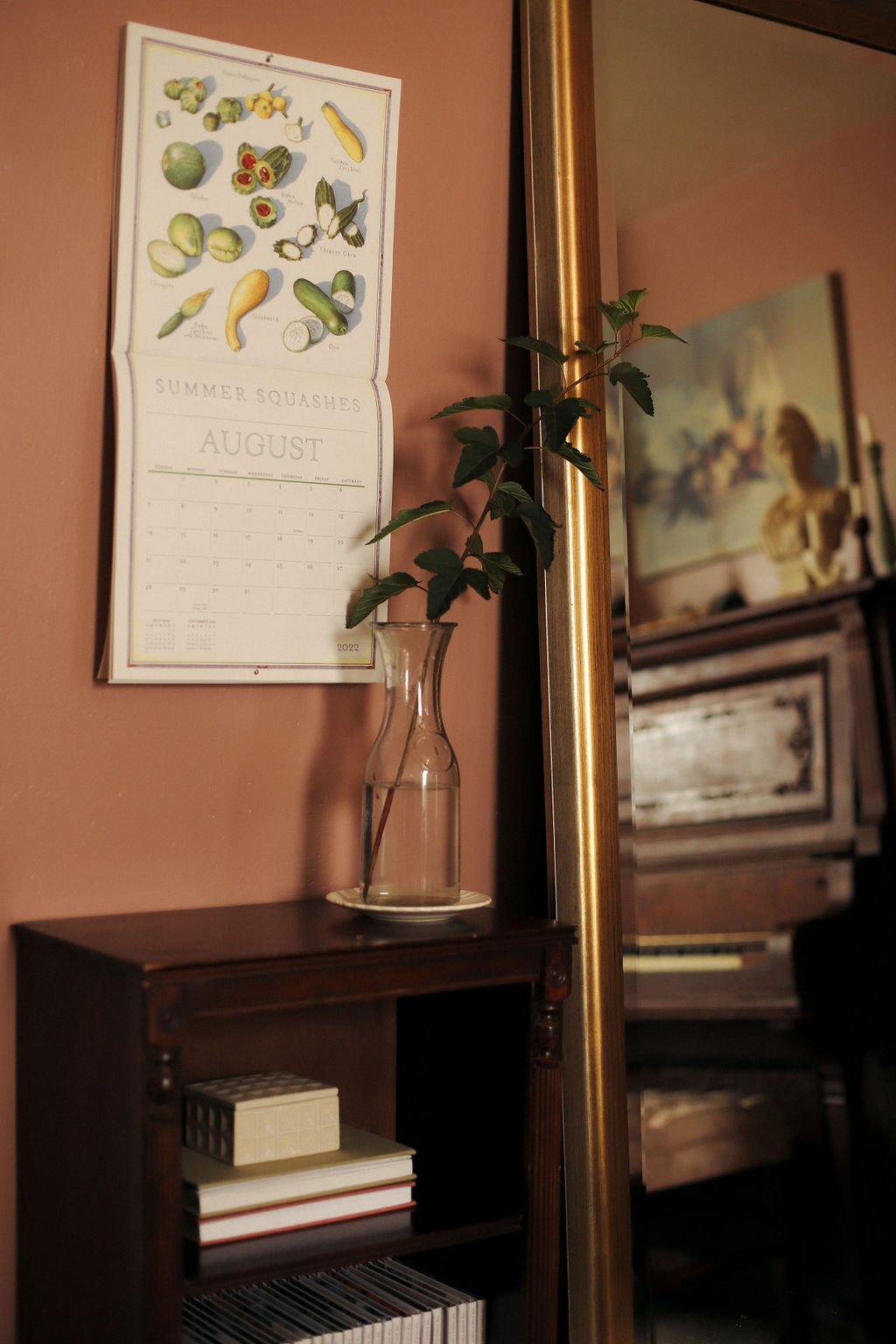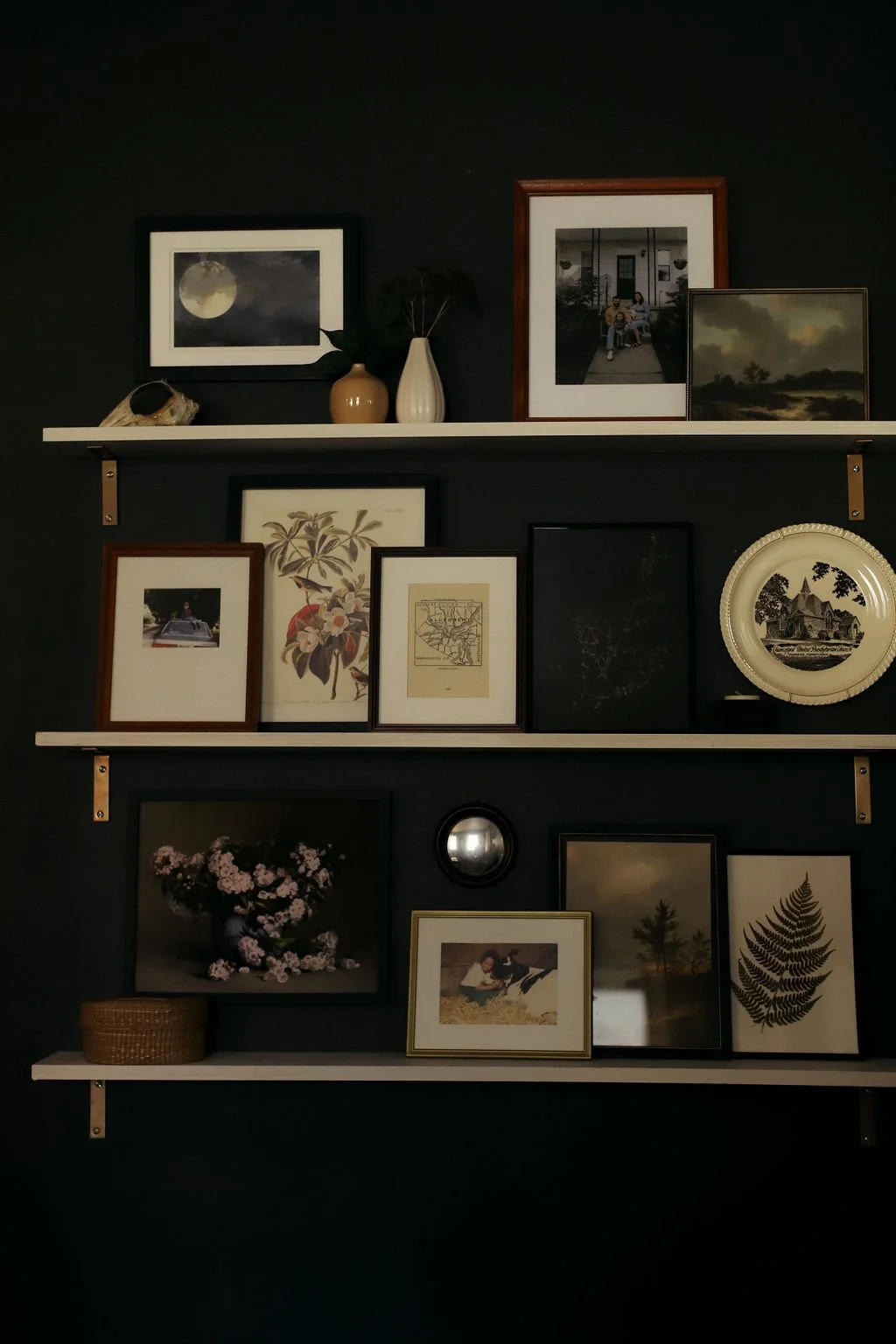Styling Shelves with Functional Decor
A nicely organized and decorated shelf can be a charming addition to a room’s decor and functionality. Yet it can be tricky to find that perfect blend between practical storage and pleasing aesthetics. For styling bookcases, open shelving, hutches, and clear glass fronted cabinetry, functional decor is my favorite!
Know your aesthetic preferences
The trick to making open storage both practical and decorative (and designing a home you love, in general) is to decide what you think is beautiful and stop buying anything that isn’t that.
For me, it’s rich wood tones, leather, simple textural fabrics like linen and cotton, earthy glazed pottery, natural stone, little accents of brass and of course, plants & greenery.
For you it might be a completely different vibe, but the point is that you won’t have to work as hard to make your living spaces feel decorated if you are intentional when selecting items that could be considered “clutter” and choose elevated pieces that can pull double duty as decor. I didn’t do it all at once and it wasn’t that expensive. I just made it a priority to only buy things I love to look at over the last several years.
These same shelves in my studio, when they were organized for interior design work. Notice the wooden file boxes across the bottom for paperwork, drafting supplies and material samples, the grey linen client binders, a white mesh bin for corraling my paint color fan decks, etc.
It’s sometime (not always!) a little more expensive to buy the prettier version of something, but you’ll save money in the long run because you won’t need to buy as much decor to make your spaces feel finished. You’ll also free up more of your closed storage (closet, cabinet and drawer space) and maybe even need less furniture all together. And if you’re like me, less to store, less to maintain, less to clean and less to manage is feeling pretty good these days.
The components of a well styled shelf
Decorative boxes, fabric bins and wicker baskets of all sizes and shapes make great shelf decor that also function as additional storage. On a larger shelf, I like to get a set of matching bins to make things cohesive. But bigger containers like this are nice for smaller shelves too — in our dining room, I have a small wooden shelf with one wicker bin on the bottom for storing cloth napkins. Wooden crates, woven baskets, metal bins and even sturdy gift wrap boxes are all great options.
The small shelf in our dining room holds the childhood journals I use for the girls topped with a pretty ceramic box, our collection of photobooks and (not pictured) a wicker basket holding our cloth napkins.
Books are an important component of shelf styling in any room. In my opinion, a bookshelf should have at least some books! Because when your shelves are all decor and no books, they run the risk of feeling like clutter.
For a more edited and elevated look, I love displaying vintage fabric-bound books I’ve purchased from thrift stores and yard sales. But as someone who truly loves reading and has a lot of books to store, I’ve taken the approach of organizing my books by color. It’s a simple way to make a collection of books feel more cohesive, and as a visual person I often remember the color of a book I want to reference before I can remember the title.
Tip: To streamline the look of your books, try removing the dust jackets. Many new hardback books are fabric bound or have lovely metallic engraving underneath the paper dust jacket.
Greenery, real, faux or even dried botanicals are perfect for adding organic shapes that break up all the hard, horizontal lines of open shelving. If I have good lighting available, I love a low maintenance live plant with a trailing habit, like a pothos. In our living room where it’s darker, I have a pair of bud vases with faux and dried stems in them.
Framed art or photography can be a great focal point in a styled shelf. Sometimes I will lean a few pieces of art, overlapping slightly on a shelf and other times I’ll use a nail or command strip to hang a frame on the back wall just above the shelf line. Whether you go art-heavy, like my living room shelves or just choose one accent piece, the color and texture added by artwork is a very welcome addition.
On our living room art shelves, I used a vintage decorative plate and a round mirror to add some contrast to all the linear shapes. I also grouped art in overlapping arrangements of 2 or 3, leaning against the wall.
Decor like ceramics, lidded boxes, small sculptures are a great finishing touch. One of my favorite tricks is to place a ceramic bowl or metal container on top of stacked horizontal books to give some variation in height. In my studio, I have a stack of books with a pretty bowl on top that’s holding all my tape measures. I like to corral items like paintbrushes and pencils into thrifted ceramic vessels.
Now that I have children, I’m often filling empty spots on our shelves with little nature finds my daughter brings home, like an interesting rock, stick or big seashell. I like the idea that she is helping to decorate our home too!
Tips for arranging items on a shelf
To me, the way you decorate your shelves is less about what type of shelf you have (floor to ceiling bookcase vs. open shelving vs. low bookshelf) and more about where the shelf is in relation to eye level. Thinking about gravity and visual weight (or perceived weight, not necessarily physical heft) is a primary consideration to styling a shelf in a way that is pleasing to the eye.
My studio shelves now: lots of books on spirituality, motherhood, home, garden and cooking, a growing collection of dried herbs in jars, my floral arranging supplies in a simple canvas tote bag, among other useful things.
It makes good sense to place larger, heavier and/or more densely spaced objects on the lower shelves and smaller, lighter items with more negative space near the top. The “break point” between the two should fall around waist height. If your shelves go the whole way down to the floor, keeping visual weight in mind is especially important.
Here is my go-to styling method:
I typically place boxes or baskets on the bottom shelf to ground the arrangement.
Books are concentrated on the lower and middle shelves with some decor.
The upper shelves are mostly art, decor, greenery and open space with just a few books.
A sketch from a client project from years ago of styling ideas for two tall etageres that flanked a fireplace. Note the belly baskets across the bottom, adding texture and continuity. Also, switching up the orientation of books, from vertical rows to horizontal stacks with the majority of books focused on the lower shelves.
When placing items, it’s helpful to think of a shelf as a series of vignettes instead of one long space to fill. Switch it up between creating one, larger, centered vignette, two smaller vignettes or an asymmetrical arrangement on each of the shelves for variety and visual movement. Allow some breathing room around your arrangements, you don’t need to fill the entire space of the shelf from side to side. Add some repetition, like 3 round shapes placed in a rough triangle across different shelves to bounce your eye around.
All these things together help create a functional, well-decorated shelf that is more beautiful than the sum of its parts.






